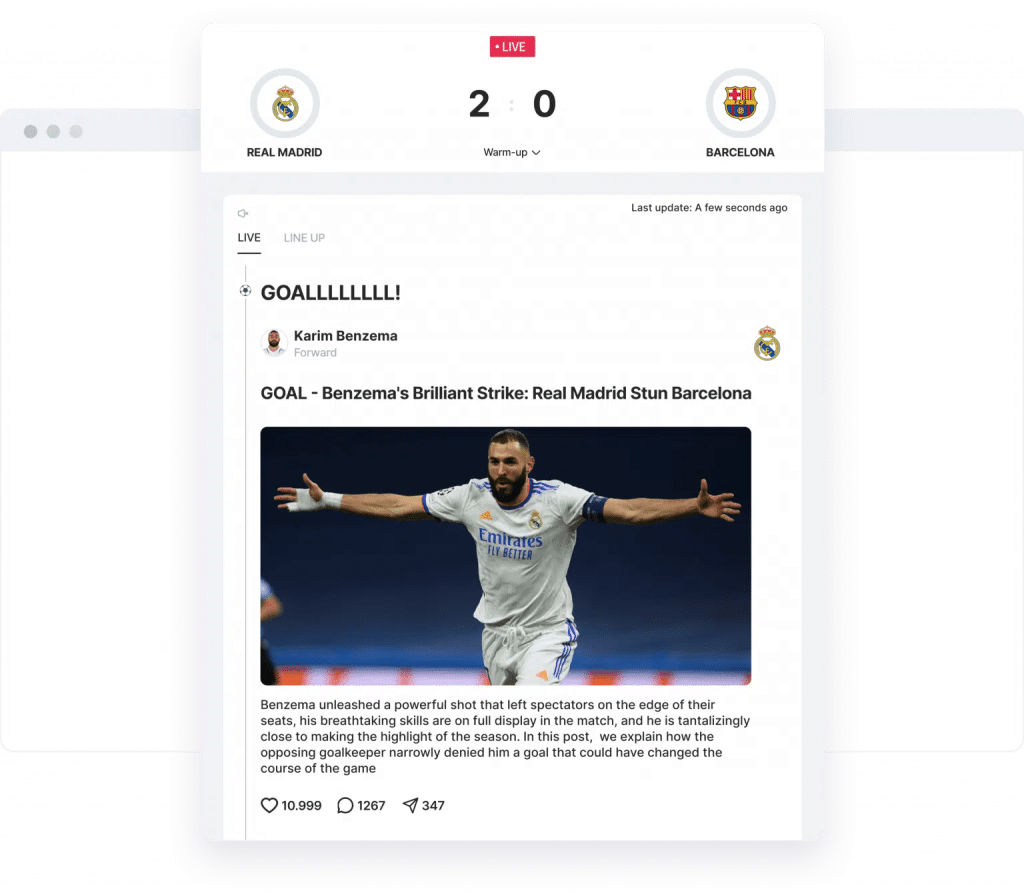You’re at an event and want to keep your audience engaged with real-time updates. You’ve heard about live blogs, but aren’t sure if they will work for your event coverage.
Live blogging offers a way to provide continuous updates, keeping your audience informed and engaged. It’s a dynamic method that can transform how you cover events.
Here’s what you need to know about live blogging for events and how it can benefit you.
What is Live Blogging for Events?
Live blogging is a real-time content delivery method. It involves posting short, frequent updates during events, allowing your audience to follow along as things happen. This approach keeps your audience engaged by providing continuous updates and dynamic coverage.
You can post text updates, photos, videos, and even social media snippets during an event. This multimedia content makes your event coverage more engaging and interactive. Readers can comment on posts, share updates on their social media, and feel like they are part of the event, even if they aren’t physically present.
Live blogs also allow you to capture the immediacy and excitement of an event as it unfolds. Whether it’s a conference, product launch, sports event, or awards ceremony, live blogging provides a way to share the experience in real-time. This method keeps your audience informed and creates a sense of community and participation.
For a deeper dive into live blogging, check out this ultimate guide to live blogging.
Benefits of Using Live Blogs for Event Coverage
Live blogging is more than just a trend; it’s a game-changer for how you engage your audience. Let’s explore why you should consider it for your next event.
Keeps Audiences Engaged
Live blogs keep your audience hooked with real-time updates. It is important to learn how to connect and engage with live blogs effectively. The continuous flow of information ensures that readers stay on your site longer, eagerly awaiting the next update. This content delivery method creates a sense of immediacy and excitement, making your audience feel like they are part of the event. Interactive elements such as polls, quizzes, and comment sections further enhance engagement, allowing readers to participate actively.
Boosts Website Traffic
One of the many benefits of live blogging is it can significantly boost your website traffic. As you provide live updates, more users will visit your site to stay informed. This influx of visitors can lead to higher page views and longer session durations. Additionally, sharing live blog updates on social media platforms can attract a broader audience, driving more traffic to your website. This increased visibility can also attract new visitors who might have yet to discover your site.
Enhances SEO
Live blogs can improve your search engine rankings. Frequent updates with relevant keywords make your content more likely to appear in search results. Search engines favor fresh and regularly updated content, and live blogs fit this criterion perfectly. By covering trending topics and events, you can capture search traffic from users looking for real-time information. This continuous content stream can help you rank higher for event-related searches, driving organic traffic to your site.
Provides Unique Perspectives
Live blogging offers a unique way to present information. Unlike traditional articles, live blogs provide a play-by-play account of events, capturing the atmosphere and key moments as they happen. This format allows you to share insights and observations that might be missed in a standard recap. By offering a unique perspective, you can differentiate your coverage from others and provide added value to your readers. This approach not only informs but also entertains. Learn how to build successful engagement strategies to make your content more appealing and memorable.
How Does Live Blogging Work?
Understanding the mechanics of live blogging can help you decide if it’s the right fit for your event. Let’s break it down.
Live blogging involves posting short, frequent updates during an event. Bloggers provide real-time information in chronological order, ensuring that the audience receives the latest developments as they happen. This format allows you to capture the immediacy and excitement of the event, keeping your audience engaged and informed.
Multimedia content plays a significant role in live blogging. Incorporating photos, videos, and social media snippets enhances the coverage, making it more dynamic and visually appealing. These elements help to break up the text and provide a richer experience for readers. For example, a photo of a keynote speaker or a video clip of a product demonstration can add depth to your updates and keep your audience interested.
Readers interact with live blogs through comments and social media. This real-time audience interaction creates a sense of community and participation, making the audience feel part of the event. You can encourage readers to share their thoughts, ask questions, and engage with the content. Social media integration allows updates to be shared across platforms, broadening the reach and attracting more viewers.
Live blogging also provides a platform for immediate feedback. Readers can comment on updates, share opinions, and suggest topics for further coverage. This interaction helps to create a two-way communication channel, making the audience feel valued and heard. It also allows you to gauge the audience’s interest and adjust your coverage accordingly.
Types of Events Suitable for Live Blogging
Only some events are a perfect fit for live blogging. Here’s how to determine if yours is.
Conferences and Seminars
Live blogging at conferences and seminars provides real-time updates on keynote speeches, panel discussions, and breakout sessions. Attendees and those who couldn’t make it can follow along with the highlights and key takeaways. This method ensures that important points and moments are captured and shared instantly. You can include quotes from speakers, photos of presentations, and summaries of discussions, making the content accessible to a broader audience.
Product Launches
During product launches, live blogging keeps your audience informed about new features, demonstrations, and announcements as they happen. This approach builds excitement and anticipation, allowing your audience to experience the launch in real-time. You can share photos of the product, videos of the demonstration, and immediate reactions from the event. This engages your audience and creates a buzz around the new product, driving interest and potential sales. Explore more reasons to use live blogs for your next product launch.
Sports Events
Live blogging sports events provide play-by-play updates, scores, and key moments, keeping fans engaged throughout the game. This method is perfect for those who can’t watch the event live but want to stay updated. You can include minute-by-minute updates, highlight reels, and fan reactions. This creates a dynamic and interactive experience, allowing fans to feel connected to the event even if they are not physically present.
Awards Ceremonies
Live blogging awards ceremonies offer real-time updates on winners, speeches, and memorable moments. This approach keeps your audience engaged with continuous coverage of the event. You can share photos of the red carpet, videos of acceptance speeches, and reactions from the audience. This keeps your readers informed and adds a layer of excitement and immediacy to the coverage, making them feel like they are part of the event.

How to Set Up a Live Blog for Your Event
Setting up a live blog might seem daunting, but it doesn’t have to be. Let’s walk through the steps.
Choose the Right Platform
The first step in setting up a live blog is selecting the right platform. Look for a platform with real-time updates, multimedia support, and user interaction features. Ensure the platform integrates smoothly with your existing website and social media channels. Check for customization options to match your branding and the ability to handle high-traffic volumes. Test the platform beforehand to ensure it meets your needs and provides a seamless user experience. For a step-by-step guide, consider setting up a WordPress live blog plugin.
Assemble Your Live Blogging Team
A successful live blog requires a dedicated team. Assemble a group that includes writers, photographers, videographers, and social media managers. Each team member should have a clear role and understand their responsibilities. Writers will handle text updates, photographers and videographers will capture visual content, and social media managers will share updates and engage with followers. Ensure everyone is familiar with the platform and has access to the necessary tools and resources.
Plan Your Content Strategy
Planning your content strategy is crucial for effective live blogging. Outline the key moments you want to cover, such as speeches, product demos, or performances. Prepare a schedule for posting updates to ensure a steady flow of content. Create templates for recurring updates, like score changes or award announcements, to save time during the event. Have a list of hashtags and keywords ready to boost visibility and engagement. To streamline the process, consider pre-writing content, such as speaker bios or background information.
Promote Your Live Blog
Promotion is vital in attracting an audience to your live blog. Start by announcing the live blog on your website and social media channels well in advance. Use email newsletters to inform your subscribers about the upcoming coverage. Create engaging graphics and teasers to generate interest. Share live blog updates on social media with relevant hashtags during the event to reach a wider audience. Encourage your followers to share the updates and engage with the content. After the event, compile the highlights into a summary post to keep the momentum going.
5 Tips for Effective Live Blogging
You’re almost ready to go live. Here are some final tips to ensure your live blog is a hit.
Keep Updates Short and Frequent
When live blogging, keep your updates short and to the point. This approach helps maintain the audience’s attention and ensures they can quickly grasp the information. Frequent updates keep the content fresh and engaging, making readers feel like they are part of the event. Aim to post every few minutes, covering key moments, quotes, and reactions. This steady stream of updates keeps the momentum going and encourages readers to stay tuned.
Incorporate Multimedia Elements
Multimedia elements like photos, videos, and GIFs make your live blog more engaging. Visual content breaks up the text and provides a richer experience for your audience. Use high-quality images to capture key moments and short video clips to highlight important event segments. Infographics can also help explain complex information quickly. Including multimedia content keeps your audience engaged and makes your updates more shareable on social media.
Encourage Audience Interaction
Engage your audience by encouraging interaction. Use polls, quizzes, and comment sections to invite readers to participate. Ask questions about the event and prompt readers to share their thoughts and opinions. This interaction makes the audience feel involved and valued. Respond to comments and acknowledge contributions to foster a sense of community. Social media integration allows readers to share updates and interact with the content, broadening the reach of your live blog.
Provide Unique Insights
Offer unique insights that go beyond the basic event coverage. Share behind-the-scenes information, expert opinions, and personal observations. This approach adds value to your live blog and differentiates it from other coverage. Highlight interesting facts, provide context, and explain the significance of key moments. Unique insights keep your audience engaged and make your content more memorable. Readers appreciate content that offers a deeper understanding of the event.
Optimize for Mobile Devices
Ensure your live blog is optimized for mobile devices. Many of your audience will follow the event on their smartphones or tablets. Use a responsive design that adjusts to different screen sizes and loads quickly. Keep text concise and use bullet points for easy reading. Ensure multimedia elements are mobile-friendly and don’t slow down the page. Test your live blog on various devices to ensure a seamless experience for all users. This optimization helps retain mobile users and enhances their engagement with your content.
Is Live Blogging Right for Your Event?
Before diving into live blogging, assessing whether it’s the best fit for your event is crucial. Think about your goals and audience preferences.
When deciding if live blogging suits your event, consider your target audience first. Are they tech-savvy and engaged online? Live blogging can be a great fit if your audience enjoys real-time updates and interactive content. Think about how they consume information and whether they would appreciate continuous updates during the event.
Next, evaluate the nature of your event. Events with ongoing activities, such as conferences, product launches, sports events, and awards ceremonies, are ideal for live blogging. These events provide a steady stream of content that keeps your audience engaged. Live blogging can capture and share these highlights effectively if your event involves significant moments that unfold over time.
Assess your resources and capabilities. Live blogging requires a dedicated team to manage updates, multimedia content, and audience interaction. Ensure you have enough staff to cover the event comprehensively. Consider the technical aspects, such as the platform you will use and the tools required for seamless updates. Ensure your team is trained and ready to handle the fast-paced environment of live blogging.
Finally, consider your goals for the event. If you aim to increase engagement, drive traffic, and provide unique insights, live blogging can help you achieve these objectives. It offers a dynamic way to connect with your audience and inform them in real-time.
Take Your Event Coverage to the Next Level with Arena
Utilizing live blogs for continuous event coverage can transform how you engage your audience. Arena offers a comprehensive suite of tools, including live blogging and live chat, to help you deliver real-time updates and dynamic content seamlessly. Our platform ensures your audience stays connected and informed, enhancing their overall experience.
With Arena, you can easily integrate live blogging into your website, provide multimedia-rich updates, and foster interactive discussions. Our no-code platform and customizable features simplify setting up and managing your live blog. Ready to elevate your event coverage? Sign up now and see how Arena can help you engage your audience like never before.



